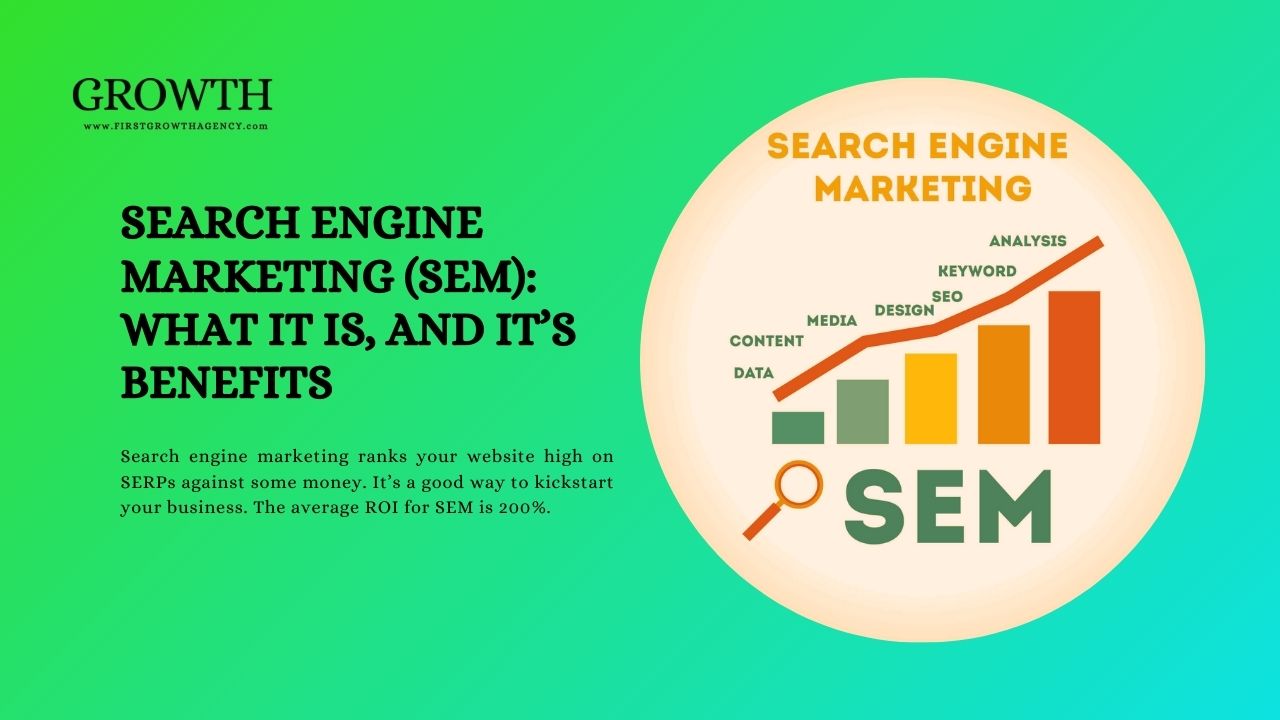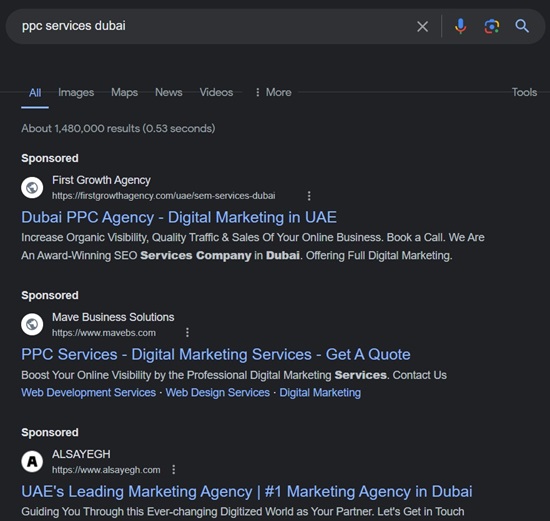You want sales, and you want them now. You’ve invested a lot in your online business, and you deserve results. Search Engine Marketing (SEM) gets you those results quickly. Search engine marketing benefits your website by making it visible to people when they search for the products you sell.
SEM means advertising on search engines. SEM and PPC are sometimes interchangeable terms for many digital marketing experts. SEM makes ads pop up when people search for specific words related to your products, services, or content. On the other hand, SEO focuses on improving content so it appears more in regular search results. Although people prefer organic results over paid ones, the average ROI for SEM is 200%. It’s huge. So it’s not like people don’t click paid SERP results. They do! Fun fact: 46% of web users can’t tell the difference between a search engine advertisement and an organic search result.
Nevertheless, SEO matters; in fact, it is the permanent solution for your online business. SEM just gives you results here and now. And for small businesses, it’s a good kickstart. That’s why 65% of small to mid-sized businesses run PPC campaigns. Read on to know what search engine marketing (SEM) is, its benefits, and how SEM marketing works.
What does a Search Engine Advertisement look like?
Think about an ad for co-working spaces in the USA. Search engine marketing ads typically appear with a headline and some text underneath. The text contains information about the products and services or provides more details that you can access by clicking the result. It’s exactly the same as how organic results appear. The only difference is that it will appear at the very top, above top-ranking organic results, with the small text sponsored written over the meta titles.
Top 5 Search Engine Marketing Benefits
1. You Get More Customers Easily
Search Engine Marketing helps you find people who really want what you sell. Unlike social media marketing, where your ads are seen by people who could be interested, SEM shows your ads to people who want to buy stuff. When someone searches for the product or service you sell, they see your ad, and that’s how you become close to making them a customer.
2. You Can Manage Ads Quick and Simple
When doing SEM, using tools like Google Ads makes everything sort out. You can begin or end your campaign whenever you feel like it. Setting your budget is easy even if you’re handling a bunch of campaigns. You can even plan them ahead of time. You just need to invest a bit of time to familiarize yourself with the SEM analytics.
3. You Outdo Competitors in Searches
SEM literally kicks SEO’s butt when it comes to beating your rivals on search engines. It’s like bribing a search engine to show your website on the top. You can zero in on keywords tied to your competitors and pop up when people search for them. That means you can catch leads before they even think about checking out your competition. You just need to dig deep into your competitor’s keywords, figure out the perfect budget, and run the campaign.
4. You Can Cut the Words You Don’t Want
When you use Google Ads for promoting your stuff online, you get this cool tool called negative keywords. It filters your ads. With this tool, you can choose words you don’t want your ads to appear for. You can use it to stay focused on reaching the people you really want to reach. For instance, if there are words similar to your main keywords but don’t really fit your ad, mark them as negative keywords. This keeps your ads on target.
5. You Pay Only When Users Click Your Ad
With Pay-Per-Click (PPC) ads, you only pay when folks click on your ad or do what you want, like buying something. It’s not like old-school ads where you pay just to show up on search engines. This way, you reach the folks who really matter without wasting money.
Also Read: Digital Marketing 101: What is SEO, SEM, and SMM?
How SEM Works in Digital Marketing?
Here’s how you should be creating a successful SEM campaign for your search engine advertisement.
Use Long-phrase Keywords
Find good words online that work for your ads. Look at what other people are saying in their ads and where they’re trying to sell stuff. Make sure the words you pick are what people type when they’re searching. Make the words longer and more exact to match what people look for. Almost 8% of search queries are phrased as questions. Also, don’t only put your ads in one spot. Try putting them on places like Microsoft Bing and Amazon, not only on Google. This helps more folks see what you’re selling.
Decide Budget Through Competitor Research
Decide how much cash you’re okay with shelling out and the highest amount you’d pay for a click. The price for SEM varies, usually falling between 500 bucks and 10,000 bucks monthly. The overall cost hinges on a few factors. Dappert, SEM expert, suggests checking out what others are throwing down for ads and maybe kicking in a bit more if you aim to snag that top page spot. They stress the importance of considering the value of gaining a customer when setting your budget.
Choose Ad Type that Fits Your Niche
Create ads by studying keywords and checking out what your competition is doing. You want to create a landing page for that where people land when they click your ad. Make sure your landing page uses the important keywords that make visitors happy. You can also use the retargeting method. It allows you to display your ads to folks who already visited your site. It helps them remember you and might convince them to buy something.
Different Kinds of Ads on Google Search
Choose the type of advertising that fits your goals, timeline, and overall strategy for promoting things online.
- Search Ads: These are text ads you spot at the top or bottom when you search a query.
- Display Ads: These are the picture ads you see while scrolling through websites and apps.
- Shopping Ads: These ads are like window displays for online stores that show a product’s image, price, and a call to action (CTA ) button.
- Video Ads: These ads pop up before, during, or after you watch videos on YouTube.
- Local Service Ads: These ads give you info like the business name, reviews, location, phone number, and hours.
Measure Your Campaign Success with SEM Analytics
Keep an eye on important stuff like Impressions (how many times your ads show up), Clicks (when people interact with your ads), Click-Through Rate (CTR), Cost-Per-Click (CPC), Cost-Per-Impression (CPM), Conversion Rate (the percentage of people who do what you want them to), and Cost-Per-Conversion (CPC).
All these numbers help tweak and improve your SEM plans. Use tools to watch how well your keywords are performing. You can contact some search engine marketing company to help you with the process.
Check: What Is PPC? Learn the Basics of Pay Per Click Marketing in 2024
Some Popular SEM Tools
With Keyword Planner, you can check out, find, group, and sort the keywords you want to focus on. It helps you figure out what to do with your SEO and SEM plans. It’s free to use.
Another free tools that helps you track the search volume of top search results in Google across various regions and languages. Google Trends tells you what’s being searched right now, or at a particular time of year.
SEMRush is one of the best SEM tools. With this tool you check what keywords your competitors are using, find important keywords you might be missing, track how well your website turns visitors into customers, and much more. The cost varies from $119.95 to $449.95 each month.
This tool allows you to spy on competitor keywords, ad tests, and provides metrics like ranking keywords, inbound links, and competitor analysis. Pricing plans cost from $39 to $299 per month.
Optmyzr provides you with advanced PPC tools for managing campaigns in bulk, using AI and machine learning for optimization and 1-click optimization for bulk campaign generation. Pricing starts from $249 per month.
If you want to avoid robots visiting your sponsored results, PPC can prevent it. It does fraud monitoring and blocks suspected robot clicks. Pricing plans range from $70 to custom pricing for the Essential and Ultimate plans.
With this SEM tool you can create high-converting landing pages. You can test them too using their A/B testing. They’ve got pre-made templates, and integrations with third-party tools. Pricing plans range from $80 to $300 per month.
Understanding the Ad Auction Process
Your ads don’t show up until Google and other search engines do an ad auction to figure out which ad to show first. They look at two main things: the most money you’re willing to pay (maximum bid) and the Quality Score of your ad. The Quality Score depends on how good the ad is overall, including the words it uses, how easy the website is to use, and the stuff in the ad.
The result of the ad auction is the ad rank, which decides where your ad appears on the results page. Even if you bid less money, you can still get a top spot if your ad is more relevant. Other things, like how much people trust your website/landing page and how many visitors you get matters too. Details about the person searching, like where they are and what they’ve searched for before, also affect which ads show up and where.
Conclusion
SEO is a slow and steady way to rank your website high without spending money. Whereas SEM is about paying for ads to show up at the top of the search results page. The more popular the keyword, the pricier it gets. SEM gets you speedy results by finding customers fast, managing ads easily, and beating your competition on search engines. You only pay when people click on your ad, which saves money. With different ad types and tools that show you what words people are searching for, SEM is like the turbo boost for your online business. You can take help from a search engine marketing company. First Growth Agency will get your ads appear on the top with the minimum budget.

